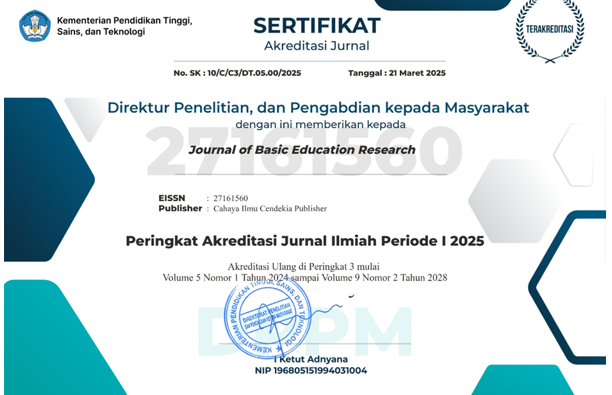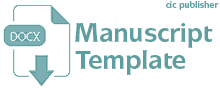The Effectiveness of Self-Regulation Strategies to Increase Achievement Motivation in Elementary School Students
Abstract
Purpose of the study: Good academic achievement will be fulfilled if students have the motivation to excel but some students have problems with the motivation to achieve. The purpose of this study is to test the effectiveness of self-regulation strategies in increasing student achievement motivation.
Methodology: This study uses an experimental quantitative method with a one group pre-test post-test research design. The sampling technique used purposive sampling, a research sample of 10 students in grade V of SDN Kedung Waduk 01 Sragen. The data collected is in the form of a score in the form of a percentage. The validity of the data was tested using pretest and posttest. Data analysis was carried out using the Wilcoxon Signed-Rank Test.
Main Findings: The results of the study showed an increase in the percentage of student achievement motivation indicators by 71.2 (high) from the initial condition of 25.9 (low). Self-regulation strategy with a standard deviation of 09.95 and a standard error mean of 4.70. After receiving treatment, the self-regulation strategy was seen to increase with a standard deviation of 8.74 and a mean error standard of 4.00.
Novelty/Originality of this study: It can be concluded that the motivation of students to achieve achievement after receiving treatment (Self Regulation Strategy) is higher before receiving treatment (Self Regulation Strategy).
References
F. Mufit, Asrizal, S. A. Hanum, and A. Fadhilah, “Preliminary research in the development of physics teaching materials that integrate new literacy and disaster literacy,” J. Phys. Conf. Ser., vol. 1481, no. 1, 2020, doi: 10.1088/1742-6596/1481/1/012041.
I. Eilks, “Science education and education for sustainable development - justifications, models, practices and perspectives,” Eurasia J. Math. Sci. Technol. Educ., vol. 11, no. 1, pp. 149–158, 2015, doi: 10.12973/eurasia.2015.1313a.
D. T. Amijaya, S. Komariah, K. P. Putri, and M. C. Devi, “Multiple regression : deteminant on profitability at islamic commercial banks in Indonesia,” Dinasti Int. J. Econ. Financ. Account., vol. 1, no. 1, pp. 21–30, 2020, doi: 10.38035/DIJEFA.
A. Ratana-Ubol and J. A. Henschke, “Cultural learning processes through local wisdom,” Int. J. Adult Vocat. Educ. Technol., vol. 6, no. 2, pp. 41–60, 2015, doi: 10.4018/ijavet.2015040104.
S. Hamid, S. Naveed, H. Ayub, and S. Akhtar, “Academic leadership during the time of crisis: Success story of implementation success from traditional to online mode of education in a low-resource context,” Cogent Soc. Sci., vol. 9, no. 1, pp. 1–15, 2023, doi: 10.1080/23311886.2023.2197302.
D. Akgunduz, “A research about the placement of the top thousand students in STEM fields in Turkey between 2000 and 2014,” Eurasia J. Math. Sci. Technol. Educ., vol. 12, no. 5, pp. 1365–1377, 2016, doi: 10.12973/eurasia.2016.1518a.
M. A. Seven, “Innovation in language learning and teaching,” Innov. Lang. Learn. Teach., vol. 8, no. 8, pp. 62–71, 2019, doi: 10.1007/978-3-030-13413-6.
A. Agbi and P. Yuangsoi, “Enhancement of critical thinking skills in students using mobile-blended learning with a collaborative inquiry-based approach,” Humanit. Arts Soc. Sci. Stud., vol. 22, no. 1, pp. 9–20, 2022.
P. T. Nugroho, D. P. Dewi, S. Fuada, H. E. Putri, F. R. Jannah, and F. W. Zanah, “Teaching sine wave concept through simulation for elementary school students,” J. Phys. Conf. Ser., vol. 1987, no. 1, 2021, doi: 10.1088/1742-6596/1987/1/012044.
A. E. Strode, P. P. Singh, C. M. Slack, and D. R. Wassenaar, “Research ethics committees in a tight spot: Approving consent strategies for child research that are prima facie illegal but are ethical in terms of national guidelines,” South African Med. J., vol. 108, no. 10, pp. 828–832, 2018, doi: 10.7196/SAMJ.2018.v108i10.13203.
I. S. M. Ramli, S. M. Maat, and F. Khalid, “The design of game-based learning and learning analytics,” Cypriot J. Educ. Sci., vol. 17, no. 5, pp. 1742–1759, 2022, doi: 10.18844/cjes.v17i5.7326.
F. Saltan and Ö. Arslan, “The use of augmented reality in formal education: A scoping review,” Eurasia J. Math. Sci. Technol. Educ., vol. 13, no. 2, pp. 503–520, 2017, doi: 10.12973/eurasia.2017.00628a.
A. Lilian, “Motivational beliefs, an important contrivance in elevating digital literacy among university students,” Heliyon, vol. 8, no. 12, p. e11913, 2022, doi: 10.1016/j.heliyon.2022.e11913.
F. T. Nephawe, “Evaluating embodied pedagogical game approach in the learning of selected prepositions of time,” JET (Journal English Teaching), vol. 9, no. 2, pp. 150–164, 2023, doi: 10.33541/jet.v9i2.4210.
A. Nor, M. Yusuf, and I. Arabi, “Strategies for improving the professionalism of islamic education teachers at university,” Tafkir Interdiscip. J. Islam. Educ., vol. 5, no. 1, pp. 40–61, 2024, doi: 10.31538/tijie.v5i1.774.
A. O. Safitri, P. A. Handayani, and V. D. Yunianti, “Pengaruh model pembelajaran discovery learning terhadap peningkatan hasil belajar siswa SD,” J. Pendidik. Tambusai, vol. 6, no. 2, pp. 9106–9114, 2022.
S. Sukarno, “Efforts to improve science learning outcomes through the problem-based learning model for students in Bengkulu,” J. Basic Educ. Res., vol. 5, no. 1, pp. 11–15, 2024, doi: 10.37251/jber.v5i1.742.
M. R. KHADAVI and S. A. MAULANA, “Hubungan sarana prasaran dan motivasi terhadap pencapaian prestasi olahraga siswa sma kota Pangkalpinang,” J. Muara Olahraga, vol. 2, no. 2, pp. 228–238, 2020, doi: 10.52060/jmo.v2i2.312.
Q. Uyuni and N. Af’idah, “Meningkatkan motivasi belajar siswa pada materi gerak ringan dengan pendekatan ilmiah berbantuan produk sederhana,” EduFisika J. Pendidik. Fis., vol. 8, no. 3, pp. 385–394, 2023, doi: 10.59052/edufisika.v8i3.29768.
R. M. Ryan and E. L. Deci, “Intrinsic and extrinsic motivation from a self-determination theory perspective: Definitions, theory, practices, and future directions,” Contemp. Educ. Psychol., vol. 61, no. April, p. 101860, 2020, doi: 10.1016/j.cedpsych.2020.101860.
M. A. Seven, “Motivation in language learning and teaching,” African Educ. Res. J., vol. 8, no. 1, pp. 62–71, 2020.
D. P. Putri, I. Rahayu, and E. A. Wahyuni, “Analisis kebutuhan bahan ajar siswa sekolah dasar berbasis etnosains pada materi zat dan campuran,” J. Nat. Sci. Educ. Res., vol. 5, no. 1, pp. 105–110, 2022.
J. W. Creswell and J. D. Creswell, Research design: qualitative, quantitative, and mixed methods approaches, 4th Editio. Newbury Park: Sage publications, 2017.
P. Guzik and B. Więckowska, “Data distribution analysis – a preliminary approach to quantitative data in biomedical research,” J. Med. Sci., vol. 92, no. 2, pp. 81–96, 2023, doi: 10.20883/medical.e869.
Razali, A. Halim, A. G. Haji, and E. Nurfadilla, “Effect of inquiry learning methods on generic science skills based on creativity level,” J. Phys. Conf. Ser., vol. 1460, no. 1, 2020, doi: 10.1088/1742-6596/1460/1/012118.
I. Bakkenes, J. D. Vermunt, and T. Wubbels, “Teacher learning in the context of educational innovation: Learning activities and learning outcomes of experienced teachers,” Learn. Instr., vol. 20, no. 6, pp. 533–548, 2010, doi: 10.1016/j.learninstruc.2009.09.001.
H. B. Santoso, R. D. Riyanti, T. Prastati, F. A. H. S. Triatmoko, A. Susanty, and M. Yang, “Learners’ online self-regulated learning skills in indonesia open university: implications for policies and practice,” Educ. Sci., vol. 12, no. 7, 2022, doi: 10.3390/educsci12070469.
T. J. Cleary and A. Kitsantas, “Motivation and self-regulated learning influences on middle school mathematics achievement,” School Psych. Rev., vol. 46, no. 1, pp. 88–107, 2017, doi: 10.1080/02796015.2017.12087607.
S. Perez-Melo and B. M. G. Kibria, “On some test statistics for testing the regression coefficients in presence of multicollinearity: a simulation study,” Stats, vol. 3, no. 1, pp. 40–55, 2020, doi: 10.3390/stats3010005.
H. Hyytinen, J. Ursin, K. Silvennoinen, K. Kleemola, and A. Toom, “Studies in educational evaluation the dynamic relationship between response processes and self-regulation in critical thinking assessments,” Stud. Educ. Eval., vol. 71, no. August, p. 101090, 2021, doi: 10.1016/j.stueduc.2021.101090.
H. L. Andrade and S. M. Brookhart, “Classroom assessment as the co-regulation of learning,” Assess. Educ. Princ. Policy Pract., vol. 27, no. 4, pp. 350–372, 2020, doi: 10.1080/0969594X.2019.1571992.
A. Aseery, “Enhancing learners’ motivation and engagement in religious education classes at elementary levels,” Br. J. Relig. Educ., vol. 46, no. 1, pp. 43–58, 2024, doi: 10.1080/01416200.2023.2256487.
V. Clinton, “Reflections versus extended quizzes: which is better for student learning and self-regulation?,” J. Scholarsh. Teach. Learn., vol. 18, no. 1, pp. 1–10, 2018, doi: 10.14434/josotl.v18i1.22508.
M. C. Butter, E. M. Aguilera, M. G. B. Quintana, L. J. Pérez, and E. S. Valenzuela, “Quality assurance for postgraduate programs: Design of a model applied on a university in Chile,” Int. Rev. Res. Open Distrib. Learn., vol. 18, no. 1, pp. 266–292, 2017, doi: 10.19173/irrodl.v18i1.2670.
C. F. Correia and C. Harrison, “Teachers’ beliefs about inquiry-based learning and its impact on formative assessment practice,” Res. Sci. Technol. Educ., vol. 38, no. 3, pp. 355–376, 2020, doi: 10.1080/02635143.2019.1634040.
Copyright (c) 2025 Bagas Fevernova Wibowo Bagas, Minsih Minsih

This work is licensed under a Creative Commons Attribution 4.0 International License.
Authors who publish with this journal agree to the following terms:
- Authors retain copyright and acknowledge that the Journal of Basic Education Research is the first publisher licensed under a Creative Commons Attribution 4.0 International License.
- Authors are able to enter into separate, additional contractual arrangements for the non-exclusive distribution of the journal's published version of the work (e.g., post it to an institutional repository or publish it in a book), with an acknowledgment of its initial publication in this journal.
- Authors are permitted and encouraged to post their work online (e.g., in institutional repositories or on their website) prior to and during the submission process, as it can lead to productive exchanges and earlier and greater citation of published work.





.png)


.png)
.png)


















